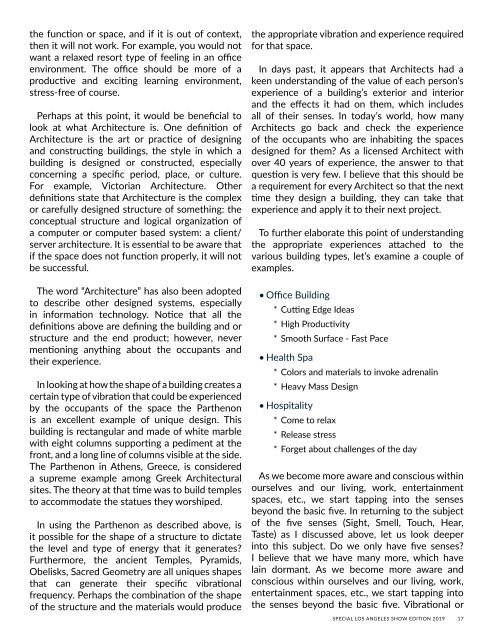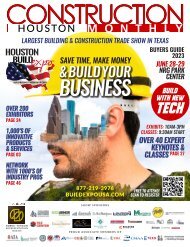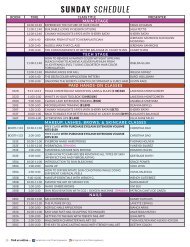Los Angeles 2019 Construction Monthly
You also want an ePaper? Increase the reach of your titles
YUMPU automatically turns print PDFs into web optimized ePapers that Google loves.
the function or space, and if it is out of context,<br />
then it will not work. For example, you would not<br />
want a relaxed resort type of feeling in an office<br />
environment. The office should be more of a<br />
productive and exciting learning environment,<br />
stress-free of course.<br />
Perhaps at this point, it would be beneficial to<br />
look at what Architecture is. One definition of<br />
Architecture is the art or practice of designing<br />
and constructing buildings, the style in which a<br />
building is designed or constructed, especially<br />
concerning a specific period, place, or culture.<br />
For example, Victorian Architecture. Other<br />
definitions state that Architecture is the complex<br />
or carefully designed structure of something: the<br />
conceptual structure and logical organization of<br />
a computer or computer based system: a client/<br />
server architecture. It is essential to be aware that<br />
if the space does not function properly, it will not<br />
be successful.<br />
The word “Architecture” has also been adopted<br />
to describe other designed systems, especially<br />
in information technology. Notice that all the<br />
definitions above are defining the building and or<br />
structure and the end product; however, never<br />
mentioning anything about the occupants and<br />
their experience.<br />
In looking at how the shape of a building creates a<br />
certain type of vibration that could be experienced<br />
by the occupants of the space the Parthenon<br />
is an excellent example of unique design. This<br />
building is rectangular and made of white marble<br />
with eight columns supporting a pediment at the<br />
front, and a long line of columns visible at the side.<br />
The Parthenon in Athens, Greece, is considered<br />
a supreme example among Greek Architectural<br />
sites. The theory at that time was to build temples<br />
to accommodate the statues they worshiped.<br />
In using the Parthenon as described above, is<br />
it possible for the shape of a structure to dictate<br />
the level and type of energy that it generates?<br />
Furthermore, the ancient Temples, Pyramids,<br />
Obelisks, Sacred Geometry are all uniques shapes<br />
that can generate their specific vibrational<br />
frequency. Perhaps the combination of the shape<br />
of the structure and the materials would produce<br />
the appropriate vibration and experience required<br />
for that space.<br />
In days past, it appears that Architects had a<br />
keen understanding of the value of each person’s<br />
experience of a building’s exterior and interior<br />
and the effects it had on them, which includes<br />
all of their senses. In today’s world, how many<br />
Architects go back and check the experience<br />
of the occupants who are inhabiting the spaces<br />
designed for them? As a licensed Architect with<br />
over 40 years of experience, the answer to that<br />
question is very few. I believe that this should be<br />
a requirement for every Architect so that the next<br />
time they design a building, they can take that<br />
experience and apply it to their next project.<br />
To further elaborate this point of understanding<br />
the appropriate experiences attached to the<br />
various building types, let’s examine a couple of<br />
examples.<br />
• Office Building<br />
* Cutting Edge Ideas<br />
* High Productivity<br />
* Smooth Surface - Fast Pace<br />
• Health Spa<br />
* Colors and materials to invoke adrenalin<br />
* Heavy Mass Design<br />
• Hospitality<br />
* Come to relax<br />
* Release stress<br />
* Forget about challenges of the day<br />
As we become more aware and conscious within<br />
ourselves and our living, work, entertainment<br />
spaces, etc., we start tapping into the senses<br />
beyond the basic five. In returning to the subject<br />
of the five senses (Sight, Smell, Touch, Hear,<br />
Taste) as I discussed above, let us look deeper<br />
into this subject. Do we only have five senses?<br />
I believe that we have many more, which have<br />
lain dormant. As we become more aware and<br />
conscious within ourselves and our living, work,<br />
entertainment spaces, etc., we start tapping into<br />
the senses beyond the basic five. Vibrational or<br />
SPECIAL LOS ANGELES SHOW EDITION <strong>2019</strong> 17

















